
Rami Ismail is one half of the team best known as Vlambeer, the developer behind games like Ridiculous Fishing, Luftrausers, and Nuclear Throne. Getting him to stay in one location long enough to have a conversation may prove difficult, so try talking to him on Twitter instead.
Let’s not talk about 2018. I didn’t like 2018. Let’s talk about video games.
Best Game: Return of the Obra Dinn
Every now and then a game comes along that is… it’s a reminder that there’s a lot left to learn about games. Leave it to Lucas Pope to teach us all a lesson in game context.
Lucas Pope once made mods for Quake, and then Lucas Pope worked on Uncharted. Lucas went independent, and over the past decade he made a game about using light to kill Dracula, a game about an elite chicken soldier nicknamed "Hardboiled", a game about the politics of being the editor of a fictional newspaper, a game about being an immigration officer in a fictional country at war, and now Lucas Pope made a game about being an 19th century insurance adjuster investigating the most ludicrous boat voyage of all time.
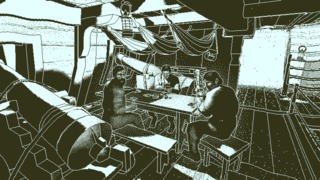
As the descriptions of Lucas’ work go from "ah yes, video games" to "what the- how could that be a video game", the quality of his work has steadily improved. Let me try and explain Return of the Obra Dinn for you.
Return of the Obra Dinn is a highly stylized, four-dimensional, 60-by-60 sudoku puzzle about DEATH aboard an abandoned ship. I wrote DEATH in caps-only because despite Obra Dinn being a game in which you can barely interact with anything at all, and you’re a passive observer to events that transpired in the past without being able to affect them, the game really only allows you to see DEATH.
Your job aboard the abandoned Obra Dinn is to find a corpse--or any remains at all--to use some sort of magical pocket watch on it. The pocket watch will allow you to see the exact moment of death of said corpse--frozen in time at exactly the moment of their passing--although you can listen for a few moments before they get stabbed/drowned/shot/crushed/exploded, and you can move around the immediate surroundings of the unfortunate demise. As you explore, you find more corpses, more clues, and more information about what happened on the ship.
This is important, because your goal is to fill a book with the names, fates, and (if relevant) the killer of each of the 60 crew members that originally boarded the Obra Dinn. While the first few fates are relatively straightforward, before you know it you’re drawing ship maps, reading up on 19th century naval traditions, and hoping that the game will confirm another triplet of fates for you.
There is no one to talk to, no one to learn from, no one to question. There is just DEATH, and the moment thereof. Every scene is only that, a silent vignette of the end of a life, that one moment where a life-long journey ends. Some had the fortune of never getting the time to process what was happening. For some, their death was slow or painful, or in the worst cases, both. For some, well, for some the pain of death wasn’t so much the physical death, but the realization that the trust they placed in someone was their ultimate mistake.
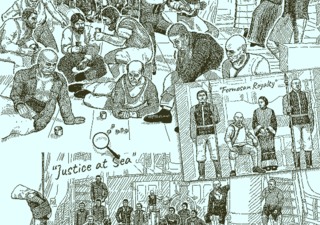
By the time the game is over, you’ve been on an adventure with the crew and passengers of the Obra Dinn, you’ve come to know their names, their fates, and the last few days of their lives. You know what each and every person did aboard the ship, who their friends were, and you know of their noble sacrifices, valiant efforts, or treacherous desires. You’ve learned of treason and trust, hope and despair, regret and perseverance.
Until you finish the book, you point your magical pocket watch at another corpse, mangled or serene, to watch the last moments of these brave men and women as they fight for their futures. You watch them struggle or die, knowing that their efforts are all for naught. Because here you are, the ship is empty, and every life aboard the Obra Dinn is ultimately reduced to a concise summary of their passing, and you’re the one penning it.
Best Touch: The way Obra Dinn only confirms fates after you succeed at correctly inputting three fates, each consisting out of two or three pieces of information. While it is theoretically possible to brute-force a solution in Obra Dinn, it has been made just awkward enough to often make deduction the path of least resistance.
Least Favorite Touch: For a game that is so focused on the thinking, but the book is often confusing to navigate. While I understand that it was created as a reference guide, not a fast-travel option, it would’ve been nice if I didn’t feel my insurance agent was completely incapable of navigating a book.
Alternative: Mario Tennis Aces
Mario Tennis Aces is not a tennis game. Mario Tennis Aces is a fighting game. It is the best fighting game of 2018.
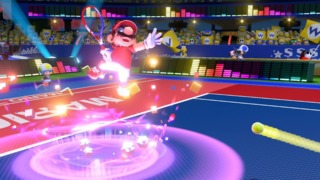
I can not overstate just how good Mario Tennis Aces is. The mechanics are incredibly simple: there’s three normal shots that act as rock-paper-scissors, there’s a lob shot, and a drop shot. The more time you spend charging up the shot (and thus the better your positioning on the field was), the more effective the shot is, and the more power bar you charge up.
Power can be spent on slow-motion, and if you have enough power built up, it’ll show you where the ball is going through a star. If you manage to position yourself in the star, you can spend some additional power for a power-shot that could even damage the opponents racket. If you don’t, and you save up enough power to fill your power bar entirely, you can use a Special shot that could shatter the opponents racket. You can also do cool trick shots, but they’re easy to mess up. If you do them early by predicting your opponents’ shot, you’ll rapidly fill up your power bar. If you do them late, you’ll lose a bit of your power bar, but you can save balls that would otherwise be out of range.
Mario Tennis Aces brings out dozens of layers of yomi, the game design term for that thing where "I think that you think that I think that you think". The game has a tiny bit more time between moves because there’s time in which the ball is traversing, but the level of planning, strategy, and psychology that can go into every swing of the racket is incredible. Take just the trick shot, for example: it’s a high-risk, high-reward move. It’s a split-second save for an impossible return. It’s a way to surprise your opponent. It’s a way to charge your power bar. It’s a way to take initiative in a rally. It’s so many things at once, all controlled with a single move.
Mario Tennis Aces includes a short but solid campaign mode, a wide selection of free-play modes, an entirely superfluous motion control mode, and a Tournament mode. These modes offer a wide variety of ways to play both seriously and playfully. It’s a game that keeps getting booted up every few days.
Best AAA Game: God of War
If you would have told me that the ever-ridiculous, hyper-violent, rage-fueled Kratos would one day be my favorite character of the year in my favorite AAA game of the year, I would’ve laughed at you. I have always appreciated the hack-‘n-slash mechanics of the older games, and thus my feelings towards the God of War franchise are very similar to my appreciation of the counter mechanics in Dead or Alive--yes, it’s mechanically solid, the design is great, but please put those in a game I don’t feel embarrassed to play.
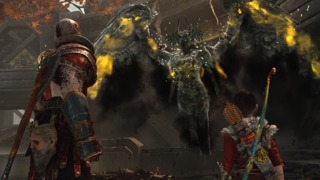
As a game developer, I often look at games from a perspective of "how would I have made this". So let me vaguely tell you about my favorite moment in God of War: Kratos--who has just fallen off a dragon, which he jumped on from atop a mountain--runs towards a temple that just had its magical powers activated, powers that could doom both Kratos and his son. As you run, you pass an allied dwarf just outside the central room--and the camera pans towards the dwarfs’ confused and panicked expression as you run to prevent Atreus’ abduction.
The last time I have felt as baffled by an in-game transition was in Call of Duty: Infinite Warfare, where you moved from ground combat into space combat back into a walkable hub zone without a single transition--but if you really looked you could find the seams. For that specific sequence in God of War, I genuinely have no idea where the seams are, because my best guess for how you’d pull off a sequence like this still comes with the caveat that during the meeting in which the sequence was ideated, it should’ve been killed for being utterly ridiculous.
As a huge fan of historical mythology and storytelling, I also really appreciated the "close-enough" variant of Norse mythology applied in the game. There’s a perfect balance of giving people with knowledge of Norse mythology insider winks--sometimes even hinting at major plot twists--while throwing those very same people off-balance with huge changes to the stories and lore. If you know nothing about the lore or don’t care about Norse mythology, God of War mixes a genuine story about parental responsibility with cleaving an ogre’s face into two in very satisfying ways.
Favorite Touch: The camera panning towards Brok as you run to stop the full might of Asgard crashing down on Atreus is a game-cinematic masterpiece, it is a perfect summary of momentum, focus, hurry, tension, panic, confusion, change, and progress, all communicated in a single camera pan and a single voice clip. That moment alone is worth a spot on this list as far as I’m concerned.
Least Favorite Touch: The way the upgrade system was presented, especially upgrades on existing nodes, was so flipped around that for a long time I thought I already had or couldn’t afford upgrades that I could easily buy.
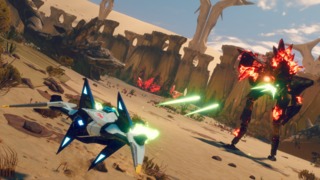
Alternative: Starlink: Battle for Atlas might be my surprise of the year. The game is the final echo of the once ubiquitous feeling toy-to-game genre, but thankfully it doesn’t require the toys. The lack of necessity for the toy contraptions means that nothing gets in the way of playing a streamlined and remarkably elegant combination of space dog-fighting, vehicular exploration, resource management, city building, and real-time strategy.
Best AA Game: Dead Cells
Every genre has a summit, and as someone who made a roguelike that he’s very proud of with Nuclear Throne, I have no shame or issues admitting that Dead Cells is probably the summit, the magnum opus, the ultimate destination of a boulder that started rolling with the original-original Spelunky. I feel that if we’re going to see a massive evolution of roguelikes, it’ll be in a different direction (like Slay The Spire), rather than an iteration on this formula.
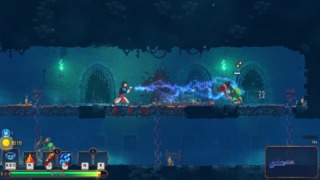
Dead Cells revels in being as much a game as a jazz instrument, asking for repetition and complete mastery to eventually be able to spontaneously freestyle your way through a game that is incredibly brutal and incredibly accessible. There’s a ton of rhythm to the game--rolling and parrying are crucial skills to learn--attacking and defense, combos, skills, abilities, spells, projectiles--there are a ton of weapons, skills, and abilities to learn, synergize, and otherwise collect. The feedback loop of the game uses an overarching permanent progress system that ensures that no matter how awful your run was, you never lose progress, and usually gain just enough of it to feel worthwhile.
More than anything, the game walks an interesting balance between feeling familiar and risky--the weapon system both encourages you to stick with your weapons as well as asking you to swap around things. Your character by the end of your 40 minutes of tense gameplay feels definitively yours, and has a story to tell. And then you die, and your weird blob of cells wakes back up in jail.
Favorite Touch: The average tempo of Dead Cells in terms of cooldowns is incredibly fast for an action RPG-like system, but it allows for experimentation.
Least Favorite Touch: The boss fights--minor boss fights in particular--feel uninspired for a game with the affordances of Dead Cells. It makes sense--how do you make boss fights that feel interesting with this unpredictable range of abilities and progress for the player?--but it feels a little disappointing.
Alternative: The Missing: J.J. MacField and the Island of Memories
SWERY’s latest game has one thing that’s incredibly SWERY--it's simultaneously brilliant and makes you wonder if things are OK with the man. The Missing is an incredibly sweet, sincere, powerful, clever puzzle-platformer in which you violently dismember your body to solve puzzles.
Best Atmosphere: Celeste
Celeste is a masterclass in platforming, offering a difficult but fair challenge navigating Madeline across the Mountain. Every screen offers an interesting and unique challenge for our double-jump, airdashing hero, and many screens offer brilliantly designed additional strawberries to pick up that secretly act as difficulty modifiers.
The mechanics stay relatively simple--if you’ve played the developers’ previous title TowerFall you’ll find movement instantly familiar. Simple hazards as spikes and springs, disappearing platforms, and moving platforms litter the starting levels, and additional and more complex mechanics show up for just long enough to master them, before almost entirely disappearing to make place for new mechanics.
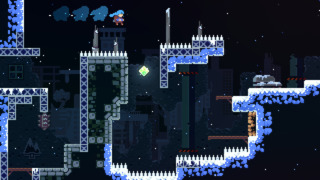
One criticism I often air at developers’ in-progress builds is that mechanics aren’t properly mined for their potential--an interesting mechanic will be introduced, a number of puzzles dedicated to it until only the obvious applications are exhausted and a new mechanic is introduced and layered on top. Celeste makes every mechanic feel like it was fully explored by the designers, with every permutation and combination designed and tried, and only the very best puzzles and challenges making it into the final game. The diligent self-constraint the developers show continues to shine as they allow certain mechanics introduced in the game to shine in isolation, and others to exist as more continuous challenges and considerations.
Yet the remarkable thing is that what elevates Celeste from “a game you should play” to “a game you will remember” is none of the above. Celeste tells an incredibly human story about overcoming the less desirable parts of oneself, as Madeline sets out to challenge, shed, and ultimately accept her flaws. The story is told through a small cast of characters and dialogue, but mostly through expert direction of music, sound, color, art, mood, and mechanics. Madeline soars with confidence when she’s feeling capable, with the relevant levels allowing the player to feel light and powerful as obstacles move in perfect sync to allow the player to dash through. She panics, hurries, shuffles, crawls through the levels and worlds in which she’s not, hindered by obstacles with just the wrong timing to stop you in your tracks, mechanics that require slow-down, or dangers that stop her from standing still or taking time to think or rest. Every mechanic feels like more than a mechanic--an intentional interactive metaphor that uses Madeline’s position or movement as subtle hint towards her emotional turmoil.
Madeline’s hurts and fears manifest in an negative alter ego that occasionally hinders, threatens, or attacks you. Remarkably, the alter ego is written as full character instead of narrative foil, with her own arc and impact on the atmosphere and mood of the levels. Celeste plays its world straight enough to be unsure if any of the colorful cast of characters you come across are real or imagination, and plays them ambiguous enough to offer clues in both directions. Ultimately, it doesn’t matter what is real and what isn’t--the only thing that has meaningful value in the world of Celeste is Madeline’s character growth. Everything exists only for that purpose, as support or foil--down to the Mountain itself.
In Celeste, by the time Madeline has learned to accept herself as whole--with fears and hurts and all--you might’ve conquered a Mountain through platforming, but I genuinely believe you’re very likely to be a better and more complete person for having been Madeline facing her struggles, too.
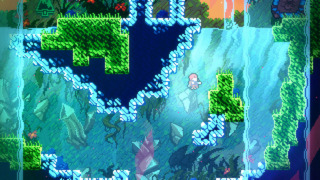
Favorite Touch: I need to mention the phenomenal accessibility work in Celeste, allowing players to modify the challenge for an extremely wide range of players. From setting the speed of the game, adjusting the mechanics, removing timing challenges, and modifying the player abilities, Celeste proves that accessibility does not need to negatively impact challenge.
That being said, it would be unfair to praise Celeste without the prevalent shout-out going to Celeste’s level design. The level design in the game is the very definition of sublime, and fulfill every single goal of level design simultaneously. The levels afford players enough freedom to experiment, while blocking obviously false routes. The challenges fit the pacing and mood of the narrative on both a micro and macro level, and screens change up length and pacing and danger and safety and distance and hazards. Every segment offers interesting and consistent mechanics, while giving players seamless in-game difficulty modifiers through optional pick-ups. On top of that, each level allows for creative speedrunning solutions, and the game does all of that so flawlessly and seamlessly that I would place the best levels of Celeste right next to Super Mario Bros.’ world 1-1.
Least Favorite Touch: Celeste’s optional difficulty modifiers come in the shape of strawberries, and the game reassures you early on that they’re entirely optional. At the end of the game, it turns out they do have a role beyond mere self-satisfying difficulty modifier, and that reveal remains the only major disappointment I had in the game.
Alternative: Red Dead Redemption 2 is 2018’s biggest indie game--it turns out that a ridiculous budget and enormous team under a single authorial vision is not just possible, but that it makes for one of the most remarkably remarkable games ever created.
The atmosphere of Red Dead Redemption 2 makes it that any flaws one might find with the game are easily secondary--from ambiguous controls to a complete disregard for the player--because it all feels like it was supposed to be exactly as it is. Although "what it is supposed to be" often means that my "rough shell heart of gold" gruff America-man decides that my "grab dynamite" input was actually meant to be "jump off the bridge and die", and that my "focus to talk" input should be processed as "grab gun and point at head".
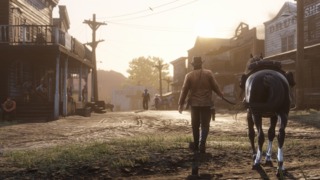
A lot of discussion about Red Dead Redemption 2 is about realism versus gameplay, but I feel that is not actually the trade-off that defines the heart of the game. At no point does Red Dead Redemption 2 pretend to be realistic, it only ever pretends to be a (considerate and incisive) highlight reel of Western movie and story tropes presented as a slow-burn nature documentary. The defining trade-off is that Red Dead Redemption 2 goes to such efforts to create unique moments using one-off mechanics and interactions that there is no way you could meaningfully do most of it well, let alone fit it on a controller. Almost every game developer would argue that you should only do something if you can do it well, and that if you make something well you should re-use it for the sake of development time of resources. Every game developer would argue that the way you interact with the world should be consistent, predictable, and made with consideration for the player. Rockstar didn’t care. It turns out that if you’re able and willing to sacrifice infinite resources, time, and player convenience, and you do it with consistency, there’s a coherence to that in itself. It also turns out that it makes every moment across the days you’ll spend in this virtual world one worth talking about.
It helps that the art and audio direction is of such scale and excellence that it can only be considered magnificent. I wish I could flesh this out into a fuller paragraph, but that’s honestly it. They are excellent. They are magnificent. They are impossible and yet here I am staring at it and listening to it. There’s nothing more to say.
I also want to point explicitly at the brilliance of Red Dead Redemption 2's narrative structure, the way the story feels like it finds you, instead of you having to go to the story. The game often hides its biggest plot points behind unremarkable missions, which makes Arthur's story feel more lifelike than any game in its genre before it. While the story itself is relatively unremarkable, the characters and moments Red Dead mines it for are often incredibly memorable--with only a few narrative moments and characters that feel like they were forced into the game to "make the story work".
Red Dead Redemption 2 is so singular, so unique, and so stubbornly itself that it comes at the expense of everything else--it is Jonathan Blow’s The Witness for "quadruple-A"--and that makes it a game I can’t necessarily recommend, but I could easily talk for hours about with almost anyone who played it.
Best Emergent Territory: Beat Saber
Did you know Guitar Hero Lightsaber VR edition is good? It’s good. Every time I’ve picked up a PlayStation Move controller, at least some part of me wanted to pretend it’s a light saber, and here’s a game that not only makes it so, it is also an exquisite rhythm-based game with perfect execution and tremendous consideration for players in terms of accessibility and playability.
In Beat Saber, the player uses a blue and a red light saber to cut through red and blue blocks that move towards them across a single straight track in virtual reality. Most blocks have an arrow to indicate in which direction a slice should be. You get bonus points for slicing through the center of the block, and you get bonus points in large and strong motions. It’s harder to explain than to play.
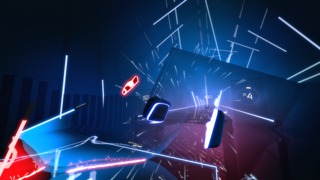
The accessibility is clearly far from an afterthought, and makes the game playable for everyone: players can lower the challenge by slowing the game down, removing certain obstacles, increase the challenge by increasing the speed of the game, or adding additional failure states, and they can adapt the experience to their preferences or needs by dampening the light flashes or special effects.
This Czech game gets so much right that it’s hard to point at any one thing that made it stand out, but lets just say that where the idea of Beat Saber is remarkable, the execution is incredible. The game's base song levels are designed in a sublime way, encouraging flow, beautiful movement, and intense swipes of the sabers.
Most of all, Beat Saber is a game that makes you forget how awkward you look swiping in the air with VR goggles on. Everything feels cool, and powerful, and choreographed. When the flow kicks in, your body moves before your brain thinks--in sync with the music, in sync with the visuals, in sync with the experience.
Favorite Touch: After a song is done, your score is displayed underneath the Beat Saber logo, to the sound and effects of fireworks in front of the logo. A perfect run will often end up with you cheering straight at the logo, arms in the air, and like all of the game, it feels cool.
Least Favorite Touch: I don’t know how I would do resuming the game after a pause, but I don’t think I would do it this way. I might scroll back a bit and just skip the points for that cut?
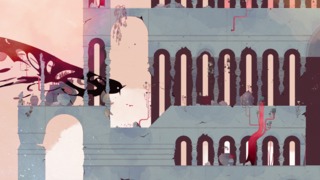
Alternative: GRIS by Nomada Studio from Barcelona is a slow, meandering, gorgeous audio-visual experience. Ambiguously obvious about grief, the game is a relatively straightforward platformer that allows you to spend most of the game feeling rather than thinking, and experiencing rather than playing. The game almost brute forces feelings through being painfully beautiful, and while I’m not sure it’s memorable for anything but the art and music, I’m not sure anything more is needed.
Best Whimsical: Astro Bot Rescue Mission
Astro Bot could not exist without VR, and plays to the strengths of its platform incredibly well. The VR is used for all sorts of tricks that’d be impossible on a traditional screen, from hiding secrets and challenging puzzles, to offering unique perspectives on action, or conjuring feelings of scale or height.
It’s hard to explain what makes Astro Bot special, because in it is simply a platformer. It’s a game where you take a cute little bot from the start of the level to the end of the level, jumping, running, stomping, and using various power-ups and upgrades.
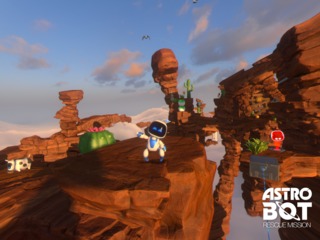
Astro Bot is meticulously made, with an incredible sense of detail and joyfulness--levels bounce and dance, the main character looks and waves at you, the colors are bright and joyous and fun, the music is pleasant and welcoming, and everything has small effects to grin at. In a way, it feels like Astro Bot smiles at you, and I found it hard to not smile back--standing looming over the world in VR.
Astro Bot continuously pulls the controller and the headset into the virtual space, which is a rather unique sensation. When you collect an upgrade, it physically gets attached to your controller in the VR space--and literally seeing a grappling hook being attached to your controller is quite a moment.
Mix that with incredibly unique VR-specific level design and challenges, and you get a very strong case for VR in general. There are a ton of good VR games--but this is the VR game for now.
Favorite Touch: VR offers a unique challenge in that the player can’t necessarily inhabit the player character from any perspective but first-person. Astro Bot solves that by making both player and player character exist within the game world. The first time an enemy attacks you rather than your avatar is genuinely confusing in the best way possible.
Least Favorite Touch: I wish all of the effort that went into unlockable levels and challenges went into more core content, but if that’s my biggest nitpick I have to admit I really have nothing here.
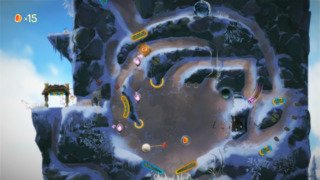
Alternative: Yoku’s Island Express is a clever mix of platforming (OK) and pinball (what). Beyond some initial and halfway pacing issues, the game delivers a lovely world, fun mechanics, and a lovingly whimsical style.
Best Multiplayer: Destiny 2: Forsaken
Destiny remains my end-of-day destination for every day that my PS4 is around, and Forsaken is the best iteration of Destiny since its original launch. Forsaken also shouldn’t be mistaken as an expansion pack--it is effectively an entirely new title. The expansion brought a total rework of the economy, the weapon system, movement and abilities, additional subclasses, an entirely new campaign with enemy types, two giant and full locations, the loot system, and an incredibly fun and entirely unique multiplayer mode called Gambit, and months of playful backdrop while catching up with friends.
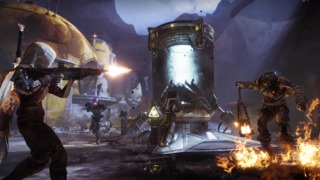
The new campaign is a decidedly darker direction than Destiny had before, a personal revenge story for our nondescript protagonist. In the most traditional Star Wars story-telling tropes, the player meets the eight targets early in the game, and then hunts them down one-by-one across a fantastical and colorful asteroid environment until they eventually face the murderer of Cayde-6--a fan-favorite character.
After you beat the campaign, Destiny 2 Forsaken adds another playable location, The Dreaming City, which is so full of secrets, extra activities, and other fun content that I still feel like I’ve only seen half of it.
Favorite Touch: The bow is the best thing to happen to Destiny.
Least Favorite Touch: The "infusion" mechanic that allows players to take the stats of a powerful item, and apply them to a less powerful item has become incredibly expensive. While that plays well into the grind, and forces people to play with different loadouts than they would normally, it turns out I don’t always want those things in my relaxing end-of-day activities.
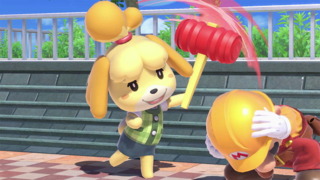
Alternative: Super Smash Bros. Ultimate is the Ultimate version of Super Smash Bros. It is fast, over-the-top, overflowing with content, and has a super-oversized campaign mode that finally and canonically confirmed that my main, Kirby, is the most powerful character in the Nintendo universe.
Best B-Game: You Are Jeff Bezos
In You Are Jeff Bezos, you play yourself waking up in the body of Amazon CEO Jeff Bezos. Your immediate goal is to spend all of Bezos' money, a staggering 150 billion dollars. The game is perfect, succinct, and a gut punch at the same time. I won’t spend more words on it. Go play it, Jeff.
Favorite Touch: You Are Jeff Bezos uses the Twine structure perfectly.
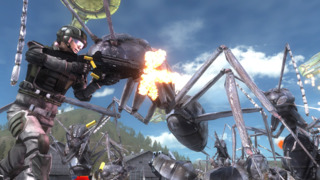
Least Favorite Touch: You are Jeff Bezos.
Alternative: Earth Defense Force 5 is the best Earth Defense Force game ever made, the best sing-along insect exterminator game ever made, and thus automatically the very best video game ever made.
Best Indie: Into The Breach
In most games, you make your move, and then the enemy takes its turn. In Into The Breach, the enemy shows what it’s going to do, you make your turn to avoid, modify, or otherwise affect those plans, and then the enemy executes its plan.
Into the Breach is a revolutionary take on turn-based strategy. Tiny maps, limited turns, just a few units, simple objectives, and almost complete information make Into The Breach into something new.
There’s so much to talk about!
I could talk about the brilliance of the way Into The Breach handles information forever: in most games, your enemy movements are the piece of incomplete information. In Into The Breach, you’re acting on several levels at once--each turn, you act on complete information, while in a round, you’re acting on almost complete information. The tension is entirely new, and feels entirely fair.
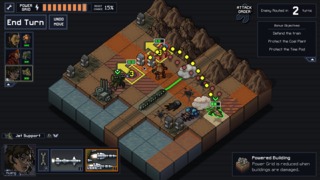
I could talk about how the redistribution of priorities is incredible. In most turn-based strategy games, your priority order tends to be protecting your units first, killing your enemies second, and defending neutral territories last. In Into The Breach, killing enemies is tertiary, defending neutral territories is critical, and protecting your units is not that big a deal. As player, you’re continuously weighing these micro and macro decisions--and there is rarely just a single good or bad solution. The tensions created in Into The Breach are so different from other strategy games, and it makes for great stories.
I could talk about the narrative structure and execution, a roguelike-ish dystopian time-travel story perfectly woven into the mechanics and texture of the game. Tiny pieces of writing, little exclamations, location establishment, an introduction so short that you might miss it if you get distracted opening a snack, it all feeds into a world that is worth saving and thus hard to abandon--despite there only being tiny scraps of life communicated.
Ultimately, Into The Breach works because every single decision feels like it is the difference between life and death, success and failure, brilliance and absolutely fucking it up. It works because it manages to make you care about your units, the world, and the results. It works because the layering of affordances and choices and risks and opportunities and information and narration and everything else just plays so perfectly together. I adore Into The Breach, and if I had to pick just one game to bring to a one-way space flight, one game to play for the rest of my life, I think I might pick this one.
Favorite Touch: The readability, which is so good and accessible that one of my favorite designers and Ridiculous Fishing co-creator Zach Gage wrote, "Building games that can be understood at a glance", one of the most useful game development talks ever, using it as an example.
Least Favorite Touch: I have nothing.
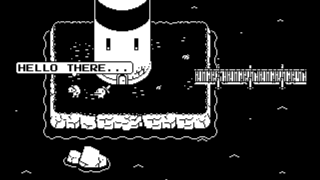
Alternative: Minit requires a bit of a disclaimer--it was created by a team of dear friends that happen to include my co-founder at Vlambeer. Normally you’d say that creates a conflict of interest, because you’d assume I like him, or have any benefit from selecting Minit for this list--but I am entirely uninvolved with Minit, and my co-founder and I don’t like each other. So, the fact that I put Minit is on this list regardless should tell you enough about how genuinely good this game is.
Minit takes every feeling from a Zelda game (Wait, what’s that? How do I get there? Can I get there yet? Oh, that item might help me do it! That explains it! Where was that thing again?), pours it into one-minute long segments full of "aha!" moments, and somehow still feels like a coherent and joyful game. Minit finds a relentless joy in pushing its systems and structure to its limits, while still creating a game that is entirely pleasant to play. Add a fun world, colorful characters in monochrome, a lovely soundtrack, and charming art to the mix, and you’ve got something special.
Best Mobile: Holedown
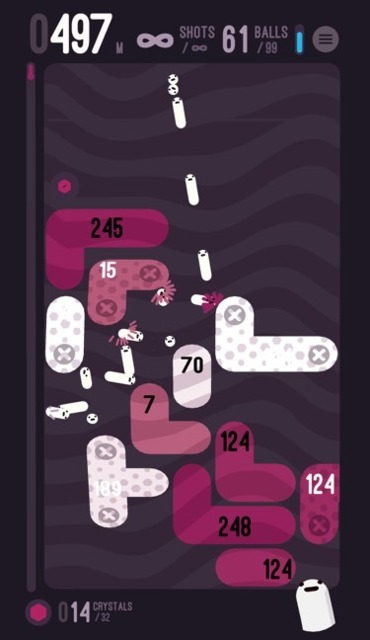
Holedown is the best of ragdolls mixed with the best of breakout, just without actual ragdolls. You try to stop a sequence of blocks from reaching the top of your screen, by hitting those blocks with a stream of balls you can fire. You aim by dragging around the screen, and when you let go the balls fire. Each block has a number on it, and the number decreases by one every time a ball hits it. When the number reaches zero, the block disappears. If there are blocks on top of it, those blocks fall and disappear too.
Holedown is made by one of the developers that introduced the word "juice" to the game developer lexicon. Juice is feedback--screenshake, special effects, little puffs of clouds when you jump, or a little inverse kinematics magic in your Leviathan Axe hits. It shouldn’t be a surprise then that Holedown nails its feedback--everything feels good and fun and pleasant, and before you know it you’re tensely watching 37 balls scattering across the screen, hoping that just one more hits that block about to game over you before the last ball returns to the top of the screen.
The progression is a huge part of the early draw of the game, as it starts extremely well-paced. Every round will move the needle a bit, moving you closer to a permanent update that will help you progress through the various stages. Every stage has tougher blocks and deeper depths, meaning you’ll have to keep up your game more precisely and for longer to clear a level.
Eventually, you’ll unlock an infinite depth mode that’ll allow you to really go for the depths. It’s a fun, relatively painless pick-up-and-play kind of game, and it keeps getting booted up whenever I feel like watching a beautiful chaos.
Favorite Touch: The rounding on the blocks is something that looks really simple, but is actually super influential on the design. In the case of Holedown, the spacing the rounded corners creates literally makes the game.
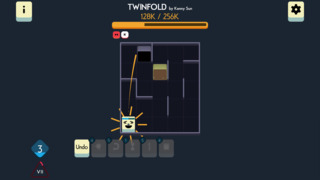
Least Favorite Touch: Progression breaks later on in the game, which means that you’ll be grinding a level you’ve already finished just to get enough upgrades to make progress.
Alternative: Twinfold mixes the idea of roguelikes and Threes. It turns out that those two mix into a perfect little mobile game, short, challenging, and smart.
Best …: Nintendo Labo
There was such a wild variety of games in 2018. Pokémon Let’s Go recaptured memories of my childhood. Iconoclasts finally came out, and was worth the wait. The Gardens Between was gorgeous and oh-so-clever. Dragon Ball FighterZ is the most ambiguously pronounceable fighting game that looks and feels like the anime. Onrush was the first racing game I loved since Split/Second. Flat Heroes and Rival Megagun and Laser League filled many gaming nights with friends. The surprising design versatility of The Messenger or The Hex. The weirdness of using letters as physics objects in Supertype. Asemblance: Oversight for taking what I loved about the original Asemblance, which I still insist is one of my favorite communal "you should’ve been there" games, and expanding on it in a genuine and sincere way without rethreading old paths. DUSK being DUSK. The painful echoes of breakup in Florence. Assassin's Creed Odyssey for making sure the franchise that started with Super Mario last year keeps up the high expectations that come with the Odyssey franchise name. The infinite charm of Frog Detective Haunted Island and Wandersong and CrossCode. Kirby: Star Allies for making Kirby cheering amidst the hellscape of a burning forest of eternal death a canon reality. Tetris Effect and Moss showing the strengths of VR. Don’t Trip for doing wonderfully weird stuff on mobile. Yoku’s Island Express for the incredible mix of platformer (here we go again) and pinball (oh wait what). LUCAH being the most stylized violent thing I've played this year. FAR: Lone Sails' solemn loudness and deafening silences.
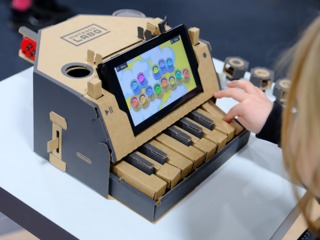
But before we get to the wildcard, I want to take a moment to applaud the industry and media for an incredible year outside of games themselves. Most of all, I want to call out Microsoft’s Xbox Accessibility Controllers. As an advisory board member of AbleGamers, I’ve been inspired by so many that are just looking to play games. Oftentimes, the difference between being able to play a game and having to suffer discomfort or being unable to play a game is a thoughtless oversight by a developer, or an input that’s unfortunate. The Xbox Accessibility Controller is a hardware solution that is clearly built-to-spec for as wide an array of potential uses. Everything from the device itself, its compatibility, and the packaging was designed flawlessly for its audience, and gaming is better for this device existing.
For me, the wildcard this year would have to be Nintendo Labo. If gaming is often meant to recapture the feeling of being a kid, losing yourself in some sort of fantasy world in which anything you could get your hands on was a motorcycle or an instrument or a house, Nintendo Labo is literally the most video game video game ever made.
From the joyful way of turning the cardboard into an object following playful instructions on the Switch, to the anticipation of slotting the Switch itself into the cardboard contraption, Labo was a perfect summary of being a kid. The choice for cardboard is incredible, as its easy to draw on, modify, and repair. But most of all, I will gleefully admit to stomping around my living room with a giant grin wearing a cardboard backpack watching my giant robot crash around a city, and it is one of the nicest memories of my year.
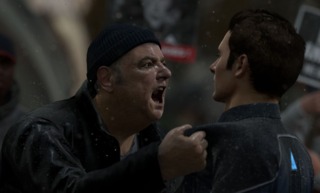
Alternative: Detroit: Become Human isn’t a good game, nor is it a good story, nor does it feature interesting characters, despite everything being beautifully captured and incredibly acted. Actually, Connor and Hank are great characters, but Quantic Dream seems to mostly write good characters if they’re cops. Detroit: Become Human’s flowchart system, the system that exposes the complex story-branches available in the game, is an incredibly clever subversion of branching narrative. Feeling the possibility space of the narrative was fascinating, as it both limits your fantasy as well as focus it within the possibilities.
I’ll be glad when 2018 is over, not just personally, but also because it seems 2019 will be an interesting one. The increased competition on PC storefronts, the proliferation of stand-alone VR, early steps for AR, games streaming, potential new platform announcements, and hopefully a lot of things I couldn’t predict if I tried. There are so many shifts happening in the industry, so fast, that I don’t think we’ll recognize video games as they are now by the end of 2019. I can’t wait to see what kind of unknowable future games will be on my list next year.